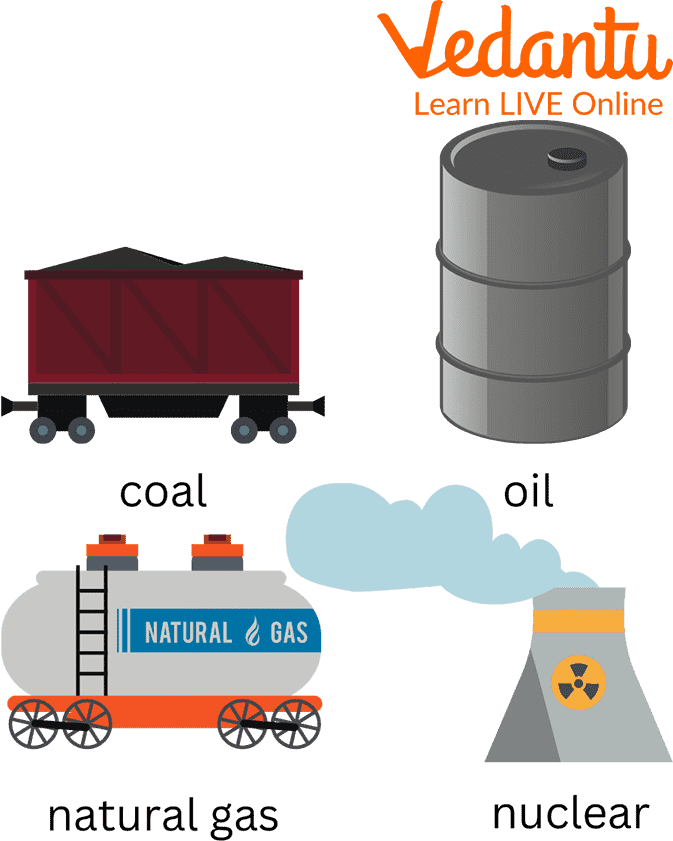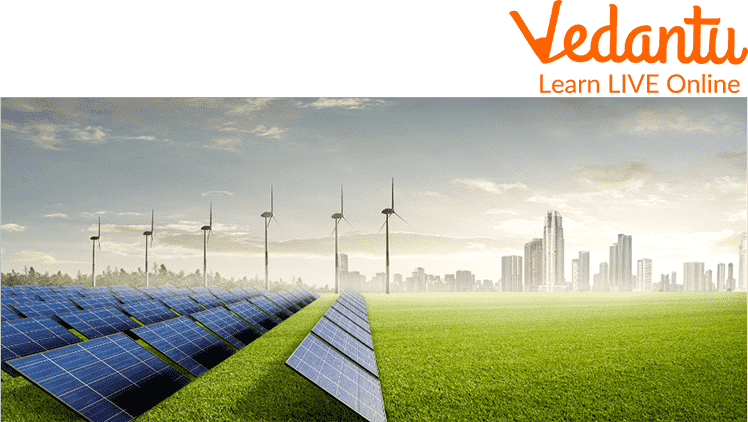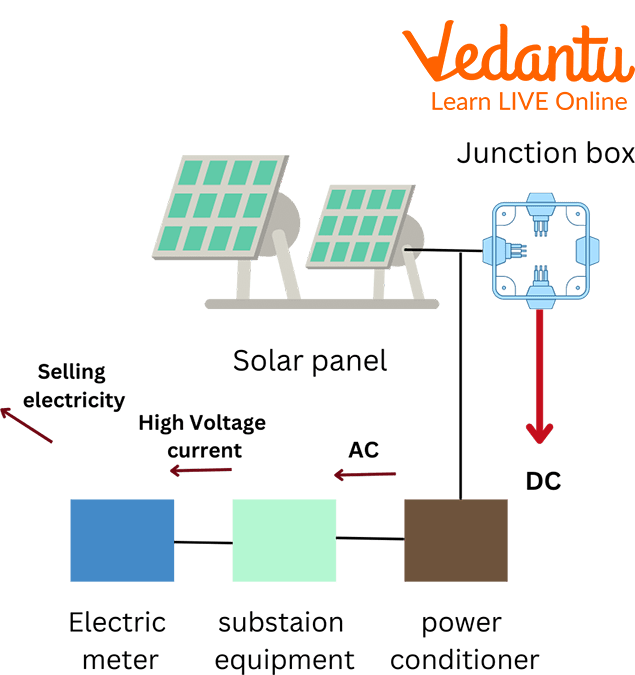




Compare Renewable and Nonrenewable Energy: Key Differences, Uses & Examples
Do you know solar and wind energy belongs to which types of energy, renewable or nonrenewable? Solar and wind energy belong to renewable energy. These are becoming more and more prominent as clean energy. In today's era, renewable energy is replacing nonrenewable energy because of its huge benefits. This article will help you in learning about what are renewable and nonrenewable sources of energy and will also help you to distinguish between renewable and nonrenewable resources. So, let us begin with the topic.
What are Renewable and Non-renewable Energy?
Renewable energy, also known as clean energy, is derived from naturally resuscitated sources or processes while nonrenewable energy, also called dirty energy, is not replenished from time to time. It is present in a limited amount in nature. Prioritising renewable energy can also improve a nation's safety by decreasing its reliance on fossil fuel-rich countries for exports.

Nonrenewable Sources of Energy
What are Renewable and Non-renewable Sources of Energy?
Renewable sources of energy include all those sources that are capable of producing and replenishing energy on their own from time to time without any human involvement. For example, sunlight, water, wind etc. Nonrenewable sources of energy are available in limited quantities in nature. These are commonly present in certain parts of the world while in other parts, these are not available. For example, fossil fuels such as oil, gas, and coal. Some nonrenewable energy sources are capable of harming mother nature.

Renewable Sources of Energy
Facts about Renewable and Nonrenewable Resources
Some facts about renewable and nonrenewable resources of energy are listed below:
Renewable sources of energy do not lead to pollution.
In the year 2021, about 38 per cent of the total electricity generated globally was done using renewable sources of energy.

Electricity Using Solar Energy
Oil, which is a nonrenewable source of energy, is considered the most versatile substance.
Nonrenewable sources of energy are high in energy and are easy to use.
Difference between Renewable and Nonrenewable Resources
The difference between renewable and nonrenewable resources are given below:
Renewable resources get replenished from time to time while nonrenewable sources do not.
Renewable resources do not harm nature while nonrenewable resources do.
Renewable resources do not get depleted with time while nonrenewable gets depleted over time.
Renewable sources of energy require a large land area for their equipment, especially wind and solar energy, while nonrenewable sources do not.

Generating Electricity using Wind
Nonrenewable sources will exhaust one day while renewable sources will not.
Renewable sources of energy emit low carbon content as compared to nonrenewable sources.
Summary
This article covers what are renewable and nonrenewable resources, facts about renewable and nonrenewable resources of energy, and the difference between renewable and nonrenewable resources. Some images are used that are creative and eye-catching to grab children's attention. It makes learning interesting, easier, and long-lasting for students. The above-given information will be useful for the children in safeguarding their future by using renewable sources instead of nonrenewable sources in their daily life. Hope you enjoyed reading this article. Ask your doubts in the comments section.
FAQs on Renewable and Nonrenewable Resources Explained for Kids
1. What are renewable resources? Can you give some examples?
Renewable resources are natural resources that can be replaced or replenished naturally over a short period. They are considered sustainable because they won't run out if we use them wisely. Common examples include:
- Sunlight (Solar Energy)
- Wind (Wind Energy)
- Water (Hydropower)
- Plants and Trees (Biomass)
- Heat from the Earth (Geothermal Energy)
2. What are non-renewable resources? What are some common examples?
Non-renewable resources are natural resources that exist in a limited or finite quantity. They take millions of years to form and cannot be easily replaced once they are used up. The most common examples are fossil fuels, which include:
- Coal
- Petroleum (from which we get petrol and diesel)
- Natural Gas
- Minerals like iron, copper, and gold
3. What is the main difference between renewable and non-renewable resources?
The main difference lies in their availability and ability to replenish. Renewable resources, like the sun and wind, are naturally restocked and can be used again and again. In contrast, non-renewable resources, like coal and petrol, are finite and will eventually run out because they are consumed much faster than they are created.
4. How can we use solar energy from the sun in our daily lives?
We can use solar energy in many ways. Solar panels on rooftops can capture sunlight and convert it into electricity to power our homes, schools, and offices. Other common uses include solar water heaters to warm up water for bathing and solar cookers to cook food using the sun's heat. Small solar panels are also used to power calculators, street lights, and garden lamps.
5. How do wind turbines work to make electricity?
Wind turbines work like giant fans in reverse. The wind pushes against the large blades, causing them to spin. This spinning motion turns a shaft connected to a generator. The generator then converts the kinetic energy of the wind into electrical energy, which can be sent through power lines to homes and businesses.
6. Why is it so important to save non-renewable resources like coal and petrol?
It is crucial to save non-renewable resources for two main reasons. First, they are limited in supply and will run out one day, leaving future generations with nothing. Second, burning fossil fuels like coal and petrol releases harmful gases that cause air pollution and contribute to climate change, harming our planet's health. Conserving them helps protect our environment and ensures they last longer.
7. If water is a renewable resource, why are we always told to save it?
While the Earth's water cycle constantly replenishes water, the amount of fresh, clean water is limited. Most of the Earth's water is salty ocean water. The process of cleaning water and pumping it to our homes requires a lot of energy. Overuse and pollution can make local freshwater sources like rivers and lakes unusable. Therefore, we must save water to ensure there's enough clean water for everyone and to protect the environment.
8. Which type of resource is better for the Earth's environment and why?
Renewable resources are generally much better for the environment. They produce little to no pollution or greenhouse gases, which is why they are often called 'clean energy'. Non-renewable resources, especially fossil fuels, cause significant air and water pollution when they are extracted and burned. Shifting towards renewable energy helps combat climate change and keeps our planet cleaner and healthier.
9. What are some simple ways a student can help conserve resources at home?
Every student can make a difference by adopting simple habits. Here are a few ways to help:
- Save Electricity: Turn off lights, fans, and electronics when you leave a room.
- Save Water: Turn off the tap while brushing your teeth and take shorter showers.
- Reduce Fuel Use: Walk, cycle, or use public transport for short distances instead of a car.
- Recycle and Reuse: Recycle paper, plastic, and glass, and reuse items whenever possible.





















